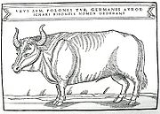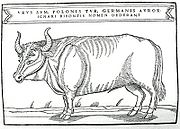
Sigismund von Herberstein
Encyclopedia
Siegmund Freiherr von Herberstein, (or Baron Sigismund von Herberstein), (August 23, 1486 – March 28, 1566) was an Carniola
n diplomat, writer, historian and member of the Holy Roman Empire
Imperial Council. He was most noted for his extensive writing on the geography, history and customs of Russia
and contributed greatly to early Western European knowledge of that area.
(German
Wippach) in the Duchy of Carniola
, now in Slovenia
, then part of the Habsburg Monarchy
's state of Inner Austria
. His parents were Leonhard von Herberstein and Barbara von Lueg, members of the prominent German-speaking family which had already resided in Herberstein Castle for nearly 200 years. Little is known of his early life apart from the fact that he became familiar with the Slovene language spoken in the region. This knowledge became significant later in his life.
In 1499 he entered the University of Vienna
to study philosophy and law. In 1506 he entered the army as an officer and served in a number of campaigns. In 1508 he was knighted by the Maximilian I, Holy Roman Emperor
personally. In 1515 he entered the Imperial council, or Parliament, and began a long and illustrious diplomatic career.
. He was feted by the ruling Habsburg
s and rewarded with titles and estates. He was twice sent to Russia
as the Austrian ambassador, in 1517 to attempt to arrange a truce between Russia and Lithuania
, and in 1526 to renew a treaty between the two signed in 1522. These extended visits (nine months in his 1517 visit) provided him with the opportunity to study a hitherto largely unknown Russian society.
both belong to the Slavic languages
. He used this ability to question a variety of people in Russia on a wide range of topics. This gave him an insight into Russia and Russians unavailable to the few previous visitors to Russia.
He probably wrote his first account of life in Russia between 1517 and 1527, but no copy of this survives. In 1526 he was asked to produce a formal report on his experiences in Russia, but this remained relatively unnoticed in the archives until he was able to find time to revise and expand it, which he possibly started in the 1530s.

 The evidence suggests that Herberstein was an energetic and capable ethnographer. He investigated in depth both by questioning locals and by critically examining the scarce existing literature on Russia. The result was his major work, a book written in Latin titled Rerum Moscoviticarum Commentarii (literally Notes on Muscovite Affairs), published in 1549. This became the main early source of knowledge in Western Europe on Russia.
The evidence suggests that Herberstein was an energetic and capable ethnographer. He investigated in depth both by questioning locals and by critically examining the scarce existing literature on Russia. The result was his major work, a book written in Latin titled Rerum Moscoviticarum Commentarii (literally Notes on Muscovite Affairs), published in 1549. This became the main early source of knowledge in Western Europe on Russia.
Although he contributed a great deal to European knowledge of Russia, he also contributed to a spelling confusion which did not emerge until the end of the 19th century and still causes disagreement: he recorded the spelling of tsar
as czar. This 'cz' spelling is against the usage of all Slavonic languages; although the spelling varies, Slavonic languages use the 'ts' pronunciation, and usually that spelling in the Romanised form. English and French began to move from the 'cz' spelling to the 'ts' spelling in the 19th century.
Carniola
Carniola was a historical region that comprised parts of what is now Slovenia. As part of Austria-Hungary, the region was a crown land officially known as the Duchy of Carniola until 1918. In 1849, the region was subdivided into Upper Carniola, Lower Carniola, and Inner Carniola...
n diplomat, writer, historian and member of the Holy Roman Empire
Holy Roman Empire
The Holy Roman Empire was a realm that existed from 962 to 1806 in Central Europe.It was ruled by the Holy Roman Emperor. Its character changed during the Middle Ages and the Early Modern period, when the power of the emperor gradually weakened in favour of the princes...
Imperial Council. He was most noted for his extensive writing on the geography, history and customs of Russia
Russia
Russia or , officially known as both Russia and the Russian Federation , is a country in northern Eurasia. It is a federal semi-presidential republic, comprising 83 federal subjects...
and contributed greatly to early Western European knowledge of that area.
Early life
Herberstein was born in 1486 in VipavaVipava, Slovenia
Vipava is a small town in western Slovenia with 1500 inhabitants. It is the center of a municipality with 5,185 people. Vipava is built near the numerous sources of the Vipava River, in the upper Vipava Valley, 102 m above sea level...
(German
German language
German is a West Germanic language, related to and classified alongside English and Dutch. With an estimated 90 – 98 million native speakers, German is one of the world's major languages and is the most widely-spoken first language in the European Union....
Wippach) in the Duchy of Carniola
Duchy of Carniola
The Duchy of Carniola was an administrative unit of the Holy Roman Empire and the Habsburg Monarchy from 1364 to 1918. Its capital was Ljubljana...
, now in Slovenia
Slovenia
Slovenia , officially the Republic of Slovenia , is a country in Central and Southeastern Europe touching the Alps and bordering the Mediterranean. Slovenia borders Italy to the west, Croatia to the south and east, Hungary to the northeast, and Austria to the north, and also has a small portion of...
, then part of the Habsburg Monarchy
Habsburg Monarchy
The Habsburg Monarchy covered the territories ruled by the junior Austrian branch of the House of Habsburg , and then by the successor House of Habsburg-Lorraine , between 1526 and 1867/1918. The Imperial capital was Vienna, except from 1583 to 1611, when it was moved to Prague...
's state of Inner Austria
Inner Austria
Inner Austria was a term used from the late 14th to the early 17th century for the Habsburg hereditary lands south of the Semmering Pass, referring to the duchies of Styria, Carinthia, Carniola and the Windic March, the County of Gorizia , the city of Trieste and assorted smaller possessions...
. His parents were Leonhard von Herberstein and Barbara von Lueg, members of the prominent German-speaking family which had already resided in Herberstein Castle for nearly 200 years. Little is known of his early life apart from the fact that he became familiar with the Slovene language spoken in the region. This knowledge became significant later in his life.
In 1499 he entered the University of Vienna
University of Vienna
The University of Vienna is a public university located in Vienna, Austria. It was founded by Duke Rudolph IV in 1365 and is the oldest university in the German-speaking world...
to study philosophy and law. In 1506 he entered the army as an officer and served in a number of campaigns. In 1508 he was knighted by the Maximilian I, Holy Roman Emperor
Maximilian I, Holy Roman Emperor
Maximilian I , the son of Frederick III, Holy Roman Emperor and Eleanor of Portugal, was King of the Romans from 1486 and Holy Roman Emperor from 1493 until his death, though he was never in fact crowned by the Pope, the journey to Rome always being too risky...
personally. In 1515 he entered the Imperial council, or Parliament, and began a long and illustrious diplomatic career.
Diplomatic career
Between 1515 and 1553, Herberstein carried out approximately 69 missions abroad, travelling throughout much of Europe, including TurkeyTurkey
Turkey , known officially as the Republic of Turkey , is a Eurasian country located in Western Asia and in East Thrace in Southeastern Europe...
. He was feted by the ruling Habsburg
Habsburg
The House of Habsburg , also found as Hapsburg, and also known as House of Austria is one of the most important royal houses of Europe and is best known for being an origin of all of the formally elected Holy Roman Emperors between 1438 and 1740, as well as rulers of the Austrian Empire and...
s and rewarded with titles and estates. He was twice sent to Russia
Russia
Russia or , officially known as both Russia and the Russian Federation , is a country in northern Eurasia. It is a federal semi-presidential republic, comprising 83 federal subjects...
as the Austrian ambassador, in 1517 to attempt to arrange a truce between Russia and Lithuania
Lithuania
Lithuania , officially the Republic of Lithuania is a country in Northern Europe, the biggest of the three Baltic states. It is situated along the southeastern shore of the Baltic Sea, whereby to the west lie Sweden and Denmark...
, and in 1526 to renew a treaty between the two signed in 1522. These extended visits (nine months in his 1517 visit) provided him with the opportunity to study a hitherto largely unknown Russian society.
Writing on Russia
Herberstein's knowledge of Slovene, acquired in his youth, allowed him to communicate freely with Russians, as Slovene and RussianRussian language
Russian is a Slavic language used primarily in Russia, Belarus, Uzbekistan, Kazakhstan, Tajikistan and Kyrgyzstan. It is an unofficial but widely spoken language in Ukraine, Moldova, Latvia, Turkmenistan and Estonia and, to a lesser extent, the other countries that were once constituent republics...
both belong to the Slavic languages
Slavic languages
The Slavic languages , a group of closely related languages of the Slavic peoples and a subgroup of Indo-European languages, have speakers in most of Eastern Europe, in much of the Balkans, in parts of Central Europe, and in the northern part of Asia.-Branches:Scholars traditionally divide Slavic...
. He used this ability to question a variety of people in Russia on a wide range of topics. This gave him an insight into Russia and Russians unavailable to the few previous visitors to Russia.
He probably wrote his first account of life in Russia between 1517 and 1527, but no copy of this survives. In 1526 he was asked to produce a formal report on his experiences in Russia, but this remained relatively unnoticed in the archives until he was able to find time to revise and expand it, which he possibly started in the 1530s.


Although he contributed a great deal to European knowledge of Russia, he also contributed to a spelling confusion which did not emerge until the end of the 19th century and still causes disagreement: he recorded the spelling of tsar
Tsar
Tsar is a title used to designate certain European Slavic monarchs or supreme rulers. As a system of government in the Tsardom of Russia and Russian Empire, it is known as Tsarist autocracy, or Tsarism...
as czar. This 'cz' spelling is against the usage of all Slavonic languages; although the spelling varies, Slavonic languages use the 'ts' pronunciation, and usually that spelling in the Romanised form. English and French began to move from the 'cz' spelling to the 'ts' spelling in the 19th century.

